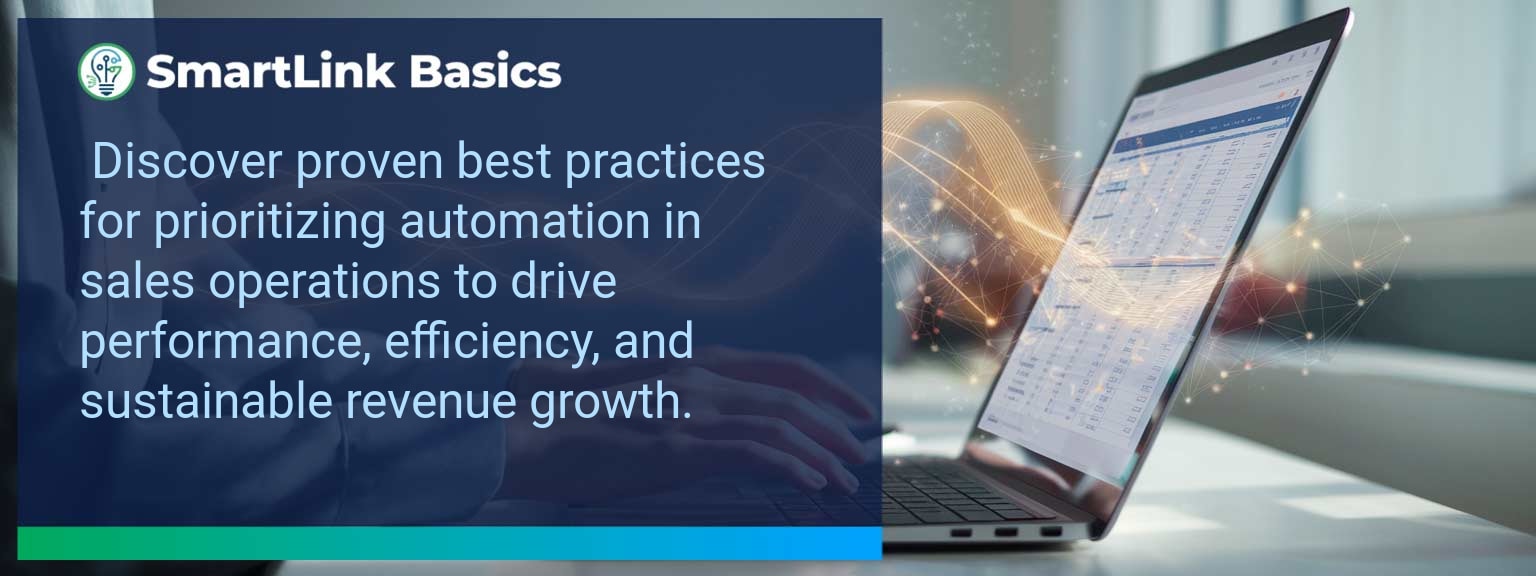Industry data shows that organizations adopting AI-driven automation achieve cost reductions of up to 30% while accelerating sales cycles by 20% or more (McKinsey, 2024). For sales leaders, AI automated workflows now define competitive advantage, enabling teams to reallocate time from repetitive tasks to high-value engagements. At SmartLink Basics, we help decision-makers implement these systems strategically, ensuring they integrate with existing revenue operations. In this article, you’ll see how AI automated workflows power business outcomes, the common obstacles that slow adoption, and practical steps to optimize processes. You’ll walk away with proven examples, a 90-day action blueprint, and measurable KPIs to track results.
- Automate repetitive administrative and CRM updates with AI.
- Integrate machine learning to personalize outreach at scale.
- Streamline approvals, quotes, and contract workflows for speed.
- Use predictive analytics to prioritize sales opportunities.
- Track adoption and performance with targeted metrics.
AI Automated Workflows: What Changed and Why It Matters
AI adoption has shifted from experimental to operational, making automated workflows a standard in high-performing sales organizations. The real advantage lies in combining workflow automation with artificial intelligence workflows to optimize every step of the revenue process. Sales leaders now use AI to synchronize touchpoints, reduce manual inputs, and ensure faster execution. For example, a B2B SaaS leader introduced automated lead enrichment and routing, cutting qualification time by 60%. Actionable insight: Audit processes for time-intensive handoffs and apply AI where repeatability is high.Redesign the Revenue Operating System With AI Automated Workflows
ICP, Segmentation, and Targeting AI-enabled segmentation uses historical wins, firmographic, and behavioral data to dynamically update ICP profiles. This ensures targeting precision without quarterly re-work. Pipeline Architecture Automated workflows push opportunities through the right stages based on engagement signals. AI flags at-risk deals for intervention. Plays and Messaging Integrated automation tools deliver personalized sequences based on buyer activity, increasing relevance at every touchpoint. Operating Cadence AI schedules follow-ups, forecast calls, and account reviews based on actual pipeline movement rather than static calendars. Actionable insight: Implement automation that adapts in real-time to both internal and buyer-driven events.Common Obstacles To Achieving Seamless Automation
The most frequent challenges are fragmented systems, inconsistent data quality, and cultural resistance. Without a unified data layer, automation amplifies errors rather than solving them. Coca-Cola Europacific Partners reported needing a full data governance upgrade before AI could improve sales workflows. Leaders must first assess infrastructure readiness and train teams to trust AI-influenced recommendations. Actionable insight: Before deployment, establish clean data practices and a single source of truth.Implementing AI To Optimize Workflows
Effective deployment of AI process optimization starts with mapping current-state processes, identifying friction points, and matching them with automation tools. For example, automating proposal generation based on CRM opportunity data can reduce turnaround from three days to one hour. Solutions combining business process automation platforms with machine learning integration enable continuous performance improvement. Actionable insight: Pilot in one high-impact stage, measure, and then expand.Tangible Benefits From Automated Processes
The benefits extend beyond time savings — sales leaders gain a scalable system. Tangible outcomes include faster quote-to-close, higher lead conversion, and better forecast accuracy. A manufacturing firm implemented AI-assisted order processing and cut errors by 40%, improving on-time delivery rates. Actionable insight: Track both speed and accuracy to measure workflow automation effectiveness.Metrics That Matter
| Category | Metric | Definition | Target |
|---|---|---|---|
| Leading | Workflow Completion Rate | % of automated sequences executed without manual intervention | 95%+ |
| Leading | AI Suggestion Adoption Rate | % of AI-generated action recommendations executed by reps | 80%+ |
| Lagging | Cycle Time Reduction | Decrease in time from lead entry to closed-won | 20%+ |
| Lagging | Revenue Per Rep | Average sales revenue generated per sales rep per quarter | +15% YoY |
| Quality | Automation Error Rate | % of workflows that trigger incorrect outcomes | <1% |
| Quality | Customer Satisfaction Post-Automation | Average CSAT score after automation implementation | ≥ 4.5/5 |
Innovations And Next Steps For AI Automation
Emerging capabilities like AI-generated playbooks, intent-driven dynamic routing, and integrated AR for virtual product demos are shaping the next wave of sales automation. Companies integrating these tools early will outpace competitors in speed and personalization. Actionable insight: Stay ahead by testing emerging automation features quarterly and aligning them with evolving buyer expectations.Get the 90-day plan, coaching rubric, and dashboard template to operationalize AI in your enablement program.
Turning AI Automation Into a Revenue Multiplier
AI automated workflows are now a strategic lever for predictable, scalable growth. This guide outlined current applications, adoption challenges, a 90-day execution plan, and measurable success criteria. To make automation pay off, sales leaders should integrate tools into one cohesive operating system and review results monthly for continuous improvement. Access more AI-driven sales enablement resources from SmartLink Basics to design a high-performance automation strategy. Sales performance depends as much on interpersonal skill as on analytical execution. Teams led by emotionally intelligent managers consistently exceed quotas, sustain higher retention, and build more durable client relationships. At SmartLink Basics, we see sales leadership reach new levels of effectiveness when emotional awareness aligns with clear commercial priorities. This approach is especially relevant for leaders seeking to enhance prospecting accuracy, improve closing ratios, and deepen customer loyalty. In this article, you’ll gain practical strategies for integrating emotional intelligence into your leadership model, learn how to apply it across prospecting, closing, and account management, and see measurable frameworks for sustained performance growth.- Anchor sales leadership in emotional intelligence to improve outcomes across the funnel.
- Diagnose and address common sales team challenges through empathetic management.
- Align sales management strategies with emotionally intelligent communication methods.
- Measure impact using both leading and lagging performance metrics.
- Commit to continuous development of EI skills for sustained advantage.
What Changed and Why It Matters Now for Sales Leadership
The complexity of modern buying cycles has elevated trust and rapport as critical sales assets. Sales leadership now demands not only strategic direction but the ability to read nuanced client signals and adjust approach in real time. Emotional intelligence in sales enables leaders to coach teams on recognizing buyer sentiment, building psychological safety, and adapting tone or messaging to suit different decision-maker profiles. Consider a sales leader who integrates weekly deal reviews with emotional context mapping—identifying where prospects show hesitation or enthusiasm. This enables targeted coaching, improving both win rates and cycle times. Leaders who invest in these skills create a competitive edge that no pitch deck can substitute.Common Struggles Facing Sales Teams
Even high-performing teams can falter without emotionally intelligent leadership. Common challenges include inconsistent pipeline quality, low rep engagement, and difficulty in sustaining client conversions. Often, these stem from misaligned communication styles, lack of empathetic feedback, and insufficient recognition of individual motivators. For example, a sales manager might over-rely on dashboard data without probing emotional factors behind stalled opportunities. By pairing pipeline analysis with one-on-one sessions focused on both skill and mindset, leaders unlock more accurate forecasts and healthier morale. Effective sales management strategies incorporate regular coaching touchpoints that blend performance metrics with personal development focus, ensuring each rep’s motivations and challenges are understood.Strategies To Align Leadership And Emotional Intelligence
Integrating emotional intelligence in sales leadership starts with intentional modeling. Leaders should exhibit active listening, impartial conflict resolution, and adaptive decision-making in both team and client interactions. Implementing structured role-play exercises allows teams to practice emotional cue recognition under realistic scenarios. Pipeline reviews can evolve into collaborative strategy sessions where reps feel safe sharing challenges. Leadership in selling also benefits from techniques like empathy mapping during prospecting sessions, helping refine targeting by understanding emotional triggers of stakeholders. Sales coaching should pair skill reinforcement with scenario-based emotional evaluations to prepare reps for diverse buying environments. The result is heightened agility and improved close rates.Tangible Benefits Of Emotionally Intelligent Leadership
Sales performance improvement isn’t theoretical when emotional intelligence becomes operational. Benefits include higher lead-to-close conversion, stronger customer relationship building, and reduced turnover. Reps coached in emotional awareness handle objections with confidence and recover more quickly from setbacks. One enterprise technology firm saw a 14% lift in quarterly revenue after implementing EI-driven pipeline reviews, largely due to better targeted engagement and improved account retention. Linking these successes to quantifiable metrics reinforces adoption across the sales organization.| Category | Metric | Definition | Target |
|---|---|---|---|
| Leading | Emotional Insight Adoption Rate | % of deals where reps document emotional drivers | 85% |
| Lagging | Closing Ratio | % of opportunities that convert to sales | 30%+ |
| Quality | Client Retention Rate | % of clients retained year-over-year | 90% |
Advancing Sales Teams With Continued EI Focus
Sustaining emotional intelligence as a core leadership competency requires structured reinforcement. Leaders should integrate EI metrics into quarterly reviews, provide ongoing training sessions, and recognize emotionally skilled performance alongside quota achievement. Continual application strengthens culture, making empathy and adaptability standard practice. This consistency positions the sales leadership team to navigate market shifts, competitive pressures, and evolving buyer behaviors with precision.Get the 90-day plan, coaching rubric, and dashboard template to operationalize AI in your enablement program.








